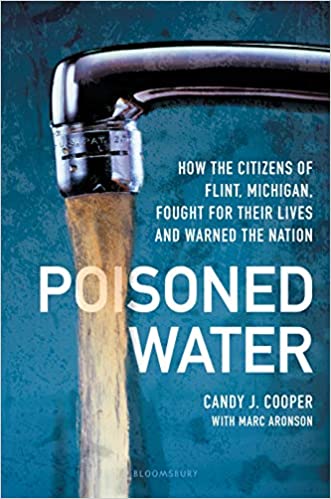By Harold C. Ford
“Flint was an example of the nation at its worst but also its best.”
— Candy J. Cooper, Poisoned Water
I’ve just added a fourth book to my personal collection of publications about Flint’s water crisis: Poisoned Water: How the Citizens of Flint, Michigan, Fought for Their Lives and Warned the Nation, written by Candy J. Cooper, with Marc Aronson, released May 19 by Bloomsbury Publishing.
Cooper is a Pulitzer Prize finalist and a Selden Ring Awardee for Investigative Reporting. An Ann Arbor native, she’s been a staff writer for four newspapers including The Detroit Free Press and San Francisco Examiner.
 Aronson is author of a number of nonfiction books for young adult audiences including award-winning Eyes of the World: Robert Capa, Gerda Taro, and the Invention of Modern Photojournalism. He is involved in a variety of projects to channel works of nonfiction to youth.
Aronson is author of a number of nonfiction books for young adult audiences including award-winning Eyes of the World: Robert Capa, Gerda Taro, and the Invention of Modern Photojournalism. He is involved in a variety of projects to channel works of nonfiction to youth.
In fact, it was Aronson who conceived the idea for the book — one that targeted middle school readers in grades five through eight — and took it to Cooper.
“Flint is an X-ray of this country,” he wrote, “and in today’s news cycle world, a story everyone is gripped by today can be forgotten by tomorrow.” Pandemic prophetic? Perhaps.
Cooper was smitten right away by the idea. “Why shouldn’t youth tell a story for youth?” she mused. “Flint is a sentinel; Flint tells the story of America; the nation must listen to Flint.”
A growing bookshelf:
Poisoned Water now joins Poison on Tap, A Bridge Magazine Analysis (staff of Bridge Magazine, 2016), The Poisoned City (Anna Clark, 2018), and Flint Fights Back (Benjamin J. Pauli, 2019) on my bookshelf — two of which I have reviewed here in East Village Magazine.
Other books inspired by Flint’s water story include Learning, Recycling and Becoming Heroes (Gale Glover, 2016), Artists Treading Water: Defining the Flint Water Crisis Through Art (Gale Glover, 2017), Appointments: A Flint Water Crisis Account (Carrie Mattern, Jessyca Mathews, DeQuindra Renae, 2018), Flint: The Death and Rebirth of a City: Unmasking the Flint Water Crisis (Gale Glover, 2018), and of course, What the Eyes Don’t See (Mona Hanna-Attisha, 2018).
A different kind of book:
So, what distinguishes this water crisis book from the others? It’s the intended adolescent audience, ages 10 and up. “I…want to write about the Flint water crisis for younger readers,” explains Cooper in her prologue.
Thus, this reviewer channeled his 44 years in public education, including eight full-time years at the middle school level, for the task of review.
For starters, Poisoned Water’s 24 chapters over 230 pages are each about 10 pages long —intellectually bite-sized and easily digestible for a younger reader.
The text is sufficiently augmented with nearly 50 photographs–many by Flint Journal/MLive photographer Jake May. Many faces will be identifiable to those familiar with Flint’s water story: Claire McClinton; Tony Palladeno, Rick Snyder, Nayyirah Shariff, Mona Hanna-Attisha, Melissa Mays, Lee Ann Walters, and others.
Many other photos effectively capture key moments in the water crisis story: local officialdom, glasses aloft, unwittingly toasting a tragic new chapter of Flint’s story; packed meetings filled with grim-faced Flintstones looking for answers and solutions; hand-scrawled signs filled with angry protestations such as “STOP POISONING OUR CHILDREN”; the easily identifiable Flint Water Plant tower; and the cutaway cross section of lead pipe that stares out at the reader like a lamprey eel looking for its next victim.
The vocabulary seems just right — easy enough for most, but with terms to inspire a dictionary assignment: rankled; contrarian; marginalized; redlining; immunocompromised; phosphates; biofilm; fecal coliform bacteria; and the oddly-spelled phlegm.
Cooper boils down complex water science into language that a middle schooler can latch on to, such as her explanation of TTHMs (total trihalomethanes):
“But too much chlorine, when mixed with organic material like dead leaves, produced elevated total trihalomethanes, or TTHMs, chemical byproducts that can lead to liver, kidney or neurological disorders, and even cancer. Not right away, but over time.”
Captive audience:
But could Cooper’s book capture and keep the attention of a younger audience? The answer to that query comes quickly: yes.
It happens right in Chapter One, where Cooper introduces the unforgettable Keishaun Wade, a student at Flint’s Southwestern Classical Academy. Wade’s grandparents earlier brought the family from the “Jim Crow South” to a “deeply segregated Flint.”
Wade was born to teen parents. His father never finished high school, resorted to drug dealing, and ended up in and out of prison during Wade’s childhood years. Wade’s family moved a dozen times to four different states, jumping from school district to school district.
Wade eventually landed in Flint and a hopeful new start at Southwestern Classical Academy. Not so much: Ice-cold classrooms with holes in the walls and trash in the halls. Shuttered water fountains and empty water dispensers. An opening morning routine “that felt to Keishaun more like practice for prison life than a stepping-stone to college.”
And, god forbid, “the history teacher who turned on the television news, wrote a question on the board, and then played computer solitaire for the rest of the class.”
Eventually, a grandmother and an aunt, an International Baccalaureate program, some great teachers “who truly cared,” and Wade’s indomitable spirit helped him to his high school diploma and a full-ride scholarship at Cornell. Cooper starts and stops her book with Wade’s story and I willingly went along for the ride.
Chapter One also introduces the reader to a historical overview of the Flint River and its namesake city with an able assist from Andrew Highsmith and his landmark work, Demolition Means Progress. While ticking off points of pride, the history told by Cooper and Highsmith is frequently unflattering and not often found in Flint-area classrooms, especially when it comes to race:
“Flint was the third most racially segregated city in the country and the most racially segregated city in the North … Flint found itself landlocked by white suburbs more interested in their own improvement and survival than in the old city, now majority black, they had left behind.”
Chapter Two takes us to and through the water switch, from Lake Huron water to Flint River water and one of this reviewer’s favorite paragraphs in the book:
“And suddenly, river water streamed into the city’s musty, old water treatment plant … It gurgled into Flint’s underground waterworks, pulsed through hundred-year-old water mains, and then dispersed from all the indoor plumbing.
It circulated through water heaters and washing machines, spurted out of faucets and shower heads, sloshed into toilets, bathtubs, and sinks. It cascaded into kitchen pots of pasta and potatoes. It topped off formula in baby bottles and poured into pitchers to make Kool-Aid as the days grew warmer …”.
A book for all ages:
In chapter after chapter, Cooper’s crisp imagery that borders on brilliance at times, her translation of complex water chemistry for common folk, the continuing introduction of bureaucratic villains and citizen-superheroes, and the narrative’s spotlight repeatedly shining on Flint’s children victims makes Poisoned Water a book for all ages.
A copy of this book should be available in libraries and classrooms all over America. Class sets should comfortably find their way into language arts, science and social studies classrooms.
EVM Staff Writer, education beat reporter, and frequent reviewer Harold C. Ford can be reached at hcford1185@gmail.com.


You must be logged in to post a comment.